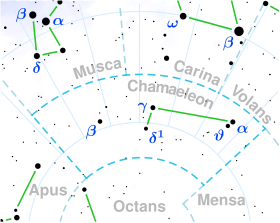Astronomy:HD 106248
| Observation data Epoch J2000.0 Equinox (celestial coordinates) | |
|---|---|
| Constellation | Chamaeleon |
| Right ascension | 12h 13m 56.46291s[1] |
| Declination | −78° 34′ 26.1715″[1] |
| Apparent magnitude (V) | 6.34±0.01[2] |
| Characteristics | |
| Spectral type | K2/3 III CNII[3] |
| U−B color index | +1.41[4] |
| B−V color index | +1.21[4] |
| Astrometry | |
| Radial velocity (Rv) | 34.5±0.4[5] km/s |
| Proper motion (μ) | RA: −4.318[1] mas/yr Dec.: −20.594[1] mas/yr |
| Parallax (π) | 9.1183 ± 0.0194[1] mas |
| Distance | 357.7 ± 0.8 ly (109.7 ± 0.2 pc) |
| Absolute magnitude (MV) | +1.10[6] |
| Details | |
| Mass | 1.19±0.82[7] M☉ |
| Radius | 10.93[8] R☉ |
| Luminosity | 49+2.3−2.2[7] L☉ |
| Surface gravity (log g) | 2.42[9] cgs |
| Temperature | 4,700±122[10] K |
| Metallicity [Fe/H] | +0.05[9] dex |
| Rotational velocity (v sin i) | <1.5[11] km/s |
| Age | 4.31+0.75−0.48[1] Gyr |
| Other designations | |
| Database references | |
| SIMBAD | data |
HD 106248, also known as HR 4649, is a solitary, orange hued star located in the southern circumpolar constellation Chamaeleon. It has an apparent magnitude of 6.34,[2] placing it near the limit for naked eye visibility. Based on parallax measurements from Gaia DR3, the object is estimated to be 358 light years away from the Solar System.[1] It appears to be receding with a heliocentric radial velocity of 34.5 km/s.[5] At its current distance, HD 106248's brightness is diminished by 0.32 due to interstellar dust and Eggen (1993) lists it as a member of the old (thick) disk population.[13]
This is an evolved red giant with a stellar classification of K2/3 III CNII[3]—intermediate between a K2 and K3 giant star. The CNII suffix indicates that it has a strong overabundance of cyano radicals in its spectrum, making it a CN star.[14] It has 119% the mass of the Sun[7] and is estimated to be 4.31 billion years old,[1] slightly younger than the Sun. However, HD 106248 has already left the main sequence and has an enlarged radius of 10.9 R☉.[8] It radiates 49 times the luminosity of the Sun from its photosphere[7] at an effective temperature of 4,700 K.[10] The star has a solar metallicity and spins slowly with a projected rotational velocity lower than 1.5 km/s.[11]
References
- ↑ 1.0 1.1 1.2 1.3 1.4 1.5 1.6 Vallenari, A. et al. (2022). "Gaia Data Release 3. Summary of the content and survey properties". Astronomy & Astrophysics. doi:10.1051/0004-6361/202243940 Gaia DR3 record for this source at VizieR.
- ↑ 2.0 2.1 Høg, E.; Fabricius, C.; Makarov, V. V.; Urban, S.; Corbin, T.; Wycoff, G.; Bastian, U.; Schwekendiek, P. et al. (March 2000). "The Tycho-2 catalogue of the 2.5 million brightest stars". Astronomy and Astrophysics 355: L27–L30. ISSN 0004-6361. Bibcode: 2000A&A...355L..27H.
- ↑ 3.0 3.1 Houk, N.; Cowley, A. P. (1975). University of Michigan Catalogue of two-dimensional spectral types for the HD stars. Volume I. Declinations −90° to −53°. Bibcode: 1975mcts.book.....H.
- ↑ 4.0 4.1 Johnson, H. L.; Mitchell, R. I.; Iriarte, B.; Wisniewski, W. Z. (1966). "UBVRIJKL Photometry of the Bright Stars". Communications of the Lunar and Planetary Laboratory 4: 99–110. Bibcode: 1966CoLPL...4...99J.
- ↑ 5.0 5.1 Gontcharov, G. A. (November 2006). "Pulkovo Compilation of Radial Velocities for 35 495 Hipparcos stars in a common system". Astronomy Letters 32 (11): 759–771. doi:10.1134/S1063773706110065. ISSN 1063-7737. Bibcode: 2006AstL...32..759G.
- ↑ Anderson, E.; Francis, Ch. (May 2012). "XHIP: An extended hipparcos compilation". Astronomy Letters 38 (5): 331–346. doi:10.1134/S1063773712050015. ISSN 1063-7737. Bibcode: 2012AstL...38..331A.
- ↑ 7.0 7.1 7.2 7.3 Charbonnel, C.; Lagarde, N.; Jasniewicz, G.; North, P. L.; Shetrone, M.; Krugler Hollek, J.; Smith, V. V.; Smiljanic, R. et al. (January 2020). "Lithium in red giant stars: Constraining non-standard mixing with large surveys in the Gaia era". Astronomy & Astrophysics 633: A34. doi:10.1051/0004-6361/201936360. ISSN 0004-6361. Bibcode: 2020A&A...633A..34C.
- ↑ 8.0 8.1 Kervella, Pierre; Arenou, Frédéric; Thévenin, Frédéric (2022). "Stellar and substellar companions from Gaia EDR3". Astronomy & Astrophysics 657: A7. doi:10.1051/0004-6361/202142146. ISSN 0004-6361. Bibcode: 2022A&A...657A...7K.
- ↑ 9.0 9.1 Anders, F. et al. (August 2019). "Photo-astrometric distances, extinctions, and astrophysical parameters for Gaia DR2 stars brighter than G = 18". Astronomy & Astrophysics 628: A94. doi:10.1051/0004-6361/201935765. ISSN 0004-6361. Bibcode: 2019A&A...628A..94A.
- ↑ 10.0 10.1 Stassun, Keivan G. et al. (9 September 2019). "The Revised TESS Input Catalog and Candidate Target List". The Astronomical Journal 158 (4): 138. doi:10.3847/1538-3881/ab3467. Bibcode: 2019AJ....158..138S.
- ↑ 11.0 11.1 De Medeiros, J. R.; Alves, S.; Udry, S.; Andersen, J.; Nordström, B.; Mayor, M. (January 2014). "A catalog of rotational and radial velocities for evolved stars". Astronomy & Astrophysics 561: A126. doi:10.1051/0004-6361/201220762. ISSN 0004-6361. Bibcode: 2014A&A...561A.126D.
- ↑ "HD 106248". SIMBAD. Centre de données astronomiques de Strasbourg. http://simbad.u-strasbg.fr/simbad/sim-basic?Ident=HD+106248.
- ↑ Eggen, O. J. (July 1993). "Evolved GK stars near the sun. I - The old disk population". The Astronomical Journal 106: 80. doi:10.1086/116622. Bibcode: 1993AJ....106...80E.
- ↑ Janes, K. A.; McClure, Robert D. (May 1971). "Strong-Cyanogen Stars: Photometry and Kinematics". The Astrophysical Journal 165: 561. doi:10.1086/150921. ISSN 0004-637X. Bibcode: 1971ApJ...165..561J.
<ref> tag with name "Gould1879" defined in <references> is not used in prior text.
 |


